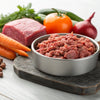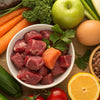How Many Grams of Raw Food for Dog: A Comprehensive Guide for Pet Owners
- Houndsy
Table of Contents
- Introduction
- Understanding Raw Food Feeding for Dogs
- Calculating the Right Amount of Raw Food
- Transitioning to a Raw Diet
- Common Concerns with Raw Feeding
- Why Houndsy Embraces a Better Feeding Experience
- Conclusion
Introduction
Did you know that up to 65% of dogs in the United States are considered overweight or obese? This startling statistic highlights a critical aspect of pet care—nutrition. As loving pet owners, we want to provide the best for our furry friends, and understanding how to feed them properly is crucial. One increasingly popular feeding method is the raw food diet, a choice many pet parents are exploring to enhance their dogs' health and vitality.
In this blog post, we will break down everything you need to know about feeding raw food to dogs, including how many grams of raw food is appropriate for your dog based on their weight, activity level, and health needs. We aim to give you a comprehensive understanding that will empower you to make informed decisions for your beloved pet.
As we delve into this topic, we will discuss the key components of a raw food diet, the recommended feeding ratios for different dog sizes and ages, practical tips for transitioning your dog to raw food, and the potential health benefits and challenges associated with this feeding method. By the end of this guide, we hope you'll feel confident about adjusting your dog's diet according to their specific needs, and if you're still navigating feeding routines, we invite you to consider solutions like the Houndsy Kibble Dispenser that can elevate everyday feeding rituals.
Understanding Raw Food Feeding for Dogs
What is Raw Feeding?
Raw feeding, often known as the Biologically Appropriate Raw Food (BARF) diet, emphasizes a natural approach to canine nutrition, mimicking what dogs would eat in the wild. A typical raw dog food diet consists primarily of raw meat, bones, and vegetables, aiming for a balance of nutrients to optimize health. This diet is built on the principle that dogs thrive on natural foods rather than commercial kibble.
Components of a Raw Diet
- Muscle Meat: Approximately 70-80% of the diet should consist of muscle meat from sources like chicken, beef, and turkey.
- Raw Edible Bones: About 10-15% of the diet should comprise raw, meaty bones, essential for dental health and calcium.
- Organ Meat: Including around 10% liver and other organs provides crucial nutrients and vitamins.
- Vegetables and Fruits: Although optional, incorporating 5-10% can offer additional fiber and antioxidants.
- Supplements: Occasionally, added nutrients like fish oil can ensure a balanced diet.
Why Choose a Raw Food Diet?
There are several compelling reasons pet owners are moving toward raw feeding:
- Improved coat condition: Dogs often show shinier coats and healthier skin.
- Better dental health: Chewing raw bones helps clean teeth and prevent plaque.
- More energy: Many dog owners report increased vitality and energy levels in their pets.
- Smaller stools: Raw diets typically result in less waste, as dogs utilize more nutrients.
Calculating the Right Amount of Raw Food
How Many Grams of Raw Food for Your Dog?
The amount of raw food a dog requires largely depends on their weight, activity level, and overall health. Generally, adult dogs should consume between 2-3% of their ideal body weight in raw food daily. Here’s a breakdown of recommended feeding amounts based on dog size:
Adult Dogs
- For active adult dogs: 3% of their ideal body weight.
- For less active or overweight dogs: 2% of their ideal body weight.
Puppies
Puppies require more food relative to their body weight due to their growth needs. Feeding guidelines suggest:
- 4-6% of their current weight until around six months of age, at which point it reduces gradually.
- Example Calculation:
- If you have a 5 kg puppy, you would feed them approximately 200-300 grams of raw food each day.
Weight-Based Calculation Guide
Here’s a simple guide based on weight to understand the recommended grams of raw food per day:
| Dog's Weight (kgs) | Daily Food (grams) |
|---|---|
| 1 - 5 kg | 25 - 125 grams |
| 5 - 15 kg | 125 - 375 grams |
| 15 - 25 kg | 375 - 625 grams |
| 25 - 35 kg | 625 - 875 grams |
| 35 - 45 kg | 875 - 1125 grams |
For Example
If your dog weighs 20 kg, the calculation would look like this:
- Active dog: 20 kg x 0.03 = 600 grams of raw food daily.
- Less active dog: 20 kg x 0.02 = 400 grams of raw food daily.
It’s crucial to assess and adjust these amounts periodically based on your dog's health condition and activity level. Regular monitoring of your dog's body condition score will help determine if these feeding recommendations are appropriate.
Transitioning to a Raw Diet
Changing your dog's diet from kibble to raw can be a smooth process with careful planning. Here are steps and tips:
Gradual Transition
- Start Slow: Begin by mixing a small amount of raw food with their existing kibble. Over the course of 7-10 days, gradually increase the proportion of raw food while decreasing kibble.
- Monitor Reactions: Keep an eye on your dog’s stool quality, energy levels, and overall health. Adjust the quantities if needed.
Safeguarding Health
- Consult Your Vet: Always consult with a veterinarian before making significant changes to your dog's diet, especially if they have pre-existing health conditions.
- Avoid Cooked Bones: Always provide raw, not cooked bones, which can splinter and cause serious harm.
- Food Safety: Practice good hygiene with raw food to prevent bacterial contamination. Wash hands and surfaces thoroughly after handling raw ingredients.
Common Concerns with Raw Feeding
Nutritional Balance
One of the most significant challenges with raw feeding is ensuring a balanced diet. While raw feeding can be highly nutritious, owners need to understand their dog's specific nutritional requirements.
- Supplements: Consider integrating supplements if preparing meals at home to fill in any nutritional gaps.
- Research and Education: Continuously educate yourself on balanced diets or consult a canine nutritionist for tailored advice.
Potential Risks
While raw feeding can have numerous benefits, there are some potential risks that should be considered:
- Disease Risk: Raw meat can carry bacteria like Salmonella or E. coli, posing a risk to both dogs and humans. Strict hygiene practices are essential.
- Food Allergies: Some dogs may develop allergies or sensitivities to certain types of raw foods. Gradually introducing new proteins can help identify problematic ingredients.
Why Houndsy Embraces a Better Feeding Experience
As we strive to elevate the dog-feeding experience, Houndsy's mission aligns with our love for convenience and design excellence. Our flagship product, the Houndsy Kibble Dispenser, allows pet owners to enjoy the feeding ritual without the hassle:
- Convenient Height: No bending over to scoop food. Our Kibble Dispenser is designed for convenience, allowing you to feed your dog using a simple crank.
- Perfect Portions: Enjoy the peace of mind that each meal measured out is consistent and healthy, every time.
- Stylish Design: Complement your home decor with a mid-century modern design that doesn’t shout ‘pet food’ but reinforces a sophisticated lifestyle.
Conclusion
Understanding how many grams of raw food for your dog is crucial to maintaining their health and well-being. By considering their weight, age, activity level, and health factors, we can better meet their nutritional needs. Remember, the benefits of raw feeding are numerous, and with proper planning, we can provide our pets with the healthiest diets possible.
As you explore the raw feeding route, reflect on your own feeding routines. Are they as convenient and aesthetically pleasing as they could be? If you’re looking for a chic solution to pet feeding that harmonizes with your home, consider our Houndsy Kibble Dispenser.
FAQ
1. How do I calculate the correct portion size for my dog? You can calculate it based on their ideal body weight—adults typically need 2-3% of their weight in raw food daily. Puppies require 4-6% depending on their age and activity level.
2. Is a raw diet safe for all dogs? While many dogs thrive on a raw diet, it's essential to consult with a veterinarian to ensure it is suitable for your dog, especially if they have underlying health issues.
3. Can I mix raw food with kibble? Yes, but if transitioning to a raw diet, it’s best to do so gradually and observe your dog's response.
4. What should I do if my dog experiences digestive issues on a raw diet? If your dog experiences diarrhea or other digestive problems, consult your veterinarian. You might need to adjust the food type or portion size.
5. How do I store raw food safely? Raw food should be stored in the refrigerator or freezer, ensuring cleanliness to avoid contamination. Always thaw food safely before feeding.
As always, we recommend working closely with your veterinary professional to ensure your dog receives the best possible care and nutrition.












